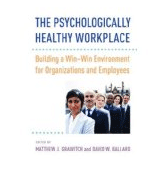“The Psychologically Healthy Workplace: Building a Win-Win Environment for Organizations and Employees”

“The Psychologically Healthy Workplace: Building a Win-Win Environment for Organizations and Employees”
Edited by Matthew J. Grawitch and David W. Ballard
American Psychological Association
Washington, D.C., 2016
Professionals can benefit from book that ‘has it all’
Reviewed by James K. Luiselli, Ed.D., ABPP, BCBA-D
The American Psychological Association has defined and promoted a Psychologically Healthy Workplace model comprised of five primary practice components. In this book, Matthew J. Grawitch and David W. Ballard address the APA model in a series of chapters focusing on each component. One chapter per component is a scholarly review of the pertinent research literature and a second chapter offers “a perspective from the field.” This melding of research and practice perspectives makes the book an outstanding resource for a wide professional audience.
The first practice component covered in the book is employee involvement in the decisions that organizations make. Evidence clearly shows that involving employees in decision-making produces a healthy workplace and fortifies performance at all levels.
The book presents many examples of employee involvement initiatives such as developing meaningful information sharing systems, forming employee advisory groups, and listening to feedback from the rank-and-file.
The second practice component is work-life balance, or “the interplay between organizational and individual health, well-being, and performance.” Among many strategies that can advantageously affect work-life balance, the book advocates telecommuting, job sharing, compressed work weeks, alternative leave options and flexible shift assignments. Most apparent is the need for organizations to empirically confirm the supports and specialized arrangements that employees endorse.
Concerning employee growth and development, the APA model articulated in the book advises organizations to build multiple career-paths as a tactic for “cultivating human capital.” Within an adult learning paradigm, employee advancement can be achieved by dedicating efforts towards competency-based training, mentoring, coaching, continuing education and leadership development.
Employee recognition is the fourth practice component for establishing a psychologically healthy workplace. There is a rich literature dealing with this matter and summarized succinctly in one of the chapters: “Employees who feel valued for their contributions, receive positive feedback on a regular basis, and are honored for what they do, have less stress and are healthier.”
Performance-based bonuses, verbal acknowledgement, fair monetary compensation and formalized peer recognition programs are just a few organizationally effective strategies.
Finally, the area of health and safety is an integral component of workplace excellence, reflected in employee end-gains such as improved productivity, less occupational stress and reduced absenteeism, health-care costs, and accident-injury rates.
The book details a host of health and safety policies that have reliably contributed to positive lifestyle and behavior choices of employees.
As someone who has worked in and consulted to profoundly unhealthy organizations, I can attest to the challenges raised in this most exemplary book. Referencing the book’s subtitle, building a win-win environment for organizations and employees requires awareness of systems-change methods which have been validated from the fields of industrial/organizational psychology, organizational behavior management and behavior systems analysis.
This book has it all for any professional seeking evidence-based practices applicable to health promotion and intervention in the workplace.
This quote from the book resonated with me: “Obtaining full commitment from senior leaders and making any initiative a success requires involvement, leadership, and accountability.”
Again, my experiences confirm that incompetent leaders produce an unhealthy workplace, marred by dissatisfaction, low morale, poor achievement and generations of employee discord.
The paradox is getting a book of this quality into the hands of these people so they can learn to behave intelligently, responsibly and ethically.
James K. Luiselli, Ed.D., ABPP, BCBA-D, is Chief Clinical Officer, Clinical Solutions, Inc. and North East Educational and Developmental Support Center, Tewksbury, Mass..
Learn more about the book: The Psychologically Healthy Workplace: Building a Win-Win Environment for Organizations and Employees
